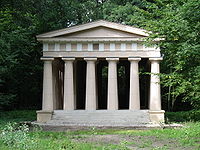Natolin Park and Palace
| Natolin Park | |
|---|---|
 Potocki Palace. | |
 | |
| Type | Municipal |
| Location | Warsaw |
| Area | 105 ha[1] |
| Created | 2006[2] |
| Status | open 2 days a week[2] |

Natolin Park is a historic park and nature reserve (1.2 km2) on the southern edge of Warsaw, Poland, in the Natolin residential neighborhood.
The park is also the location of the Natolin Palace. Together, the two are known as the Palace and Park Complex in Natolin (Polish: Zespół Pałacowo-Parkowy w Natolinie).
History
Park and palace
The history of Natolin begins at end of the 17th century, when the King of Poland

In late 18th century the
The paintings inside the palace were replaced with
The Alexander Potocki's death ended the splendid period of developments of Natolin. The next administrators of estate, son August and the daughter-in-law Alexandra did not maintain the property so Natolin began to fall into decline. The palace and park were used only occasionally, mainly as temporary accommodation for owners' relatives.
In the first half of the 20th century Natolin passed to the
See also
References
- ^ "Formy ochrony przyrody". wilanow.pl (in Polish). Archived from the original on 2008-02-10. Retrieved 2008-02-18.
- ^ a b Tomasz Urzykowski (February 7, 2006). "Park Natoliński otworzy się dla zwiedzających". wilanow.pl (in Polish). Retrieved 2008-02-18.
- ^ a b c d e f "History of Natolin". natolin.edu.pl. Retrieved 2008-02-18.
External links
- Natolin European Centre
- College of Europe
- (in Polish) Natolin
